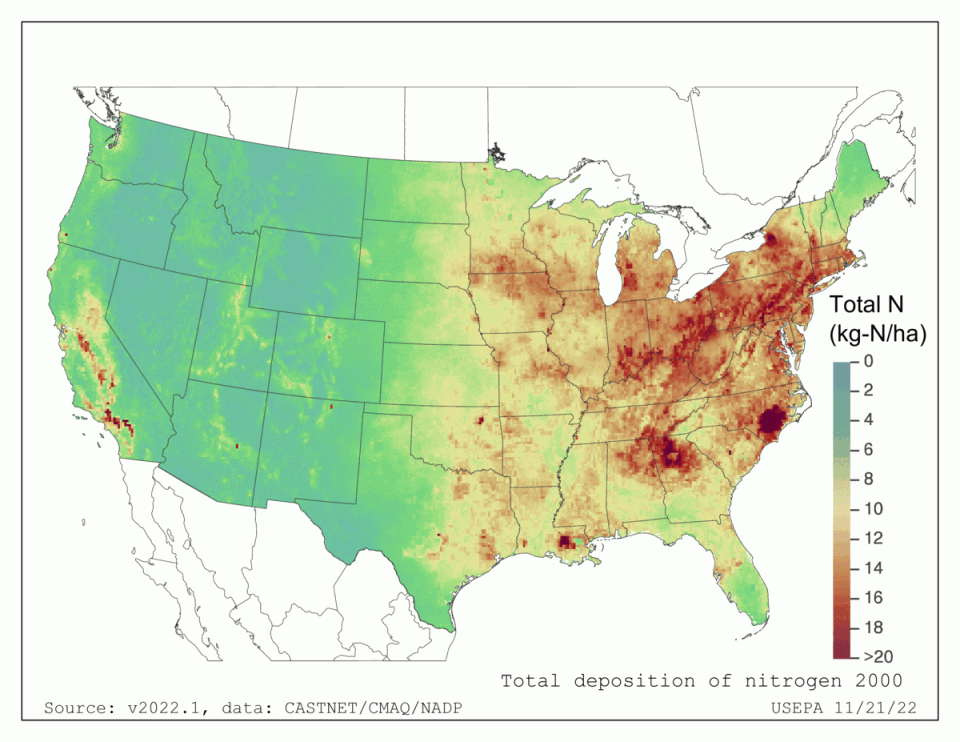Estimating Atmospheric Deposition with CMAQ
The atmospheric deposition of nitrogen, sulfur and other chemical species to underlying surfaces is an important exposure pathway that can contribute or lead to the degradation of air, land and water quality as well as reductions in the benefits humans may derive from ecosystems. Understanding the processes and outcomes associated with atmospheric deposition is needed to improve existing Clean Air Act Secondary Standards.
Scientists at the EPA actively participate in the National Atmospheric Deposition Program's (NADP) Total Deposition (TDep) Science Committee. The mission of TDep is to improve estimates of atmospheric deposition by advancing the science of measuring and modeling atmospheric wet, dry, and total deposition of species such as sulfur, nitrogen and mercury. TDep provides a forum for the exchange of information on current and emerging issues within a broad multi-organization context including atmospheric scientists, ecosystem scientists, resource managers, and policy makers. One of the goals of the NADP's TDep Science Committee is to provide estimates of total sulfur and nitrogen deposition for use in critical loadsA quantitative estimate of an exposure to one or more pollutants below which significant harmful effects on specified sensitive elements of the environment do not occur according to present knowledge. and other ecological assessments.

The deposition estimates provided on the TDep website were developed using an approach that combines measured air concentration and wet deposition data and modeled deposition velocity and dry deposition data. Wet deposition values are obtained from combining the National Trends Network (NTN) measured values of precipitation chemistry with precipitation estimates from the Parameter-elevation Regression on Independent Slopes Model (PRISM). Dry deposition values are estimated by combining air concentration data from the Clean Air Status and Trends Network (CASTNET) with modeled deposition velocity and then fusing with modeled dry deposition fluxes. Modeled data were obtained from the CMAQ model. Details of the original methodology for developing the data set as well as comparisons of these data to other deposition estimates is provided in Schwede and Lear (2014). A modernized method was developed to eliminate dependencies on deprecated software requirements, and has resulted in substantial improvements on the adaptability of the model, and correction of known limitations. Details on this update will be provided in Beachley et al. (in preparation).
The current release is version 2022.02 which contains files for the years 2000-2021 and uses modeled time-series from the EPA’s Air Quality Time Series (EQUATES) project using CMAQ v5.3.2 (Appel et al., 2021). Data products are available as GEOtiff gridded deposition fields and maps that can be downloaded on the NADP TDep Committee web page.
Related Links
- Clean Air Act Secondary Standards
- National Atmospheric Deposition Program (NADP)
- NADP Total Deposition Science Committee (TDEP)
- National Trends Network (NTN)
- Parameter-elevation Regression on Independent Slopes Model (PRISM)
- Clean Air Status and Trends Network (CASTNET)
- Ammonia Monitoring Network (AMoN)
- Critical Loads of Atmospheric Deposition Science Committee (CLAD)
References
Appel, K. W., Bash, J. O., Fahey, K. M., Foley, K. M., Gilliam, R. C., Hogrefe, C., Hutzell, W. T., Kang, D., Mathur, R., Murphy, B. N., Napelenok, S. L., Nolte, C. G., Pleim, J. E., Pouliot, G. A., Pye, H. O. T., Ran, L., Roselle, S. J., Sarwar, G., Schwede, D. B., Sidi, F. I., Spero, T. L., and Wong, D. C. (2021) The Community Multiscale Air Quality Model Version 5.3 and 5.3.1: System Updates and Evaluation, Geosci. Model Dev. doi: https://doi.org/10.5194/gmd-14-2867-2021
Schwede, D., & Lear, G.C. (2014). A novel hybrid approach for estimating total deposition in the United States. Atmospheric Environment, 92, 207-220. doi: 10.1016/j.atmosenv.2014.04.008
